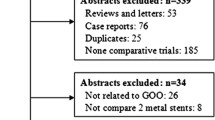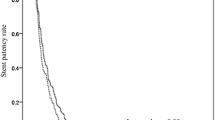Abstract
Background and aims
Malignant gastric outlet obstruction (GOO) can be palliated by endoscopic placement of self-expandable metal stents (SEMSs). Studies comparing uncovered (USEMSs) and covered (CSEMSs) SEMSs have yielded inconclusive results. This meta-analysis compared USEMSs with CSEMSs in patients with GOO caused by intrinsic and extrinsic tumors.
Methods
Potentially relevant articles were identified by searching PubMed, the Cochrane Library, and Medline. The primary outcome was stent dysfunction. Relationships between characteristics of tumors causing GOO and the stent dysfunction rate following USEMSs and CSEMS placement were assessed.
Results
Overall, six randomized controlled trials and 12 observational studies, including 2431 patients, were identified. Rate of stent dysfunction did not differ significantly between USEMSs and CSEMSs (odds ratio [OR], 0.95; 95% confidence interval [CI], 0.73–1.25, I2 = 44%), but there was heterogeneity. Meta-regression analysis showed that heterogeneity of stent dysfunction was caused by a difference in the ratio of intrinsic-to-extrinsic tumors causing GOO between studies (coefficient, 0.944; 95% CI, 0.30–1.58). Studies were divided into intrinsic and extrinsic tumor groups. Subgroup analysis showed that the stent dysfunction rate did not differ between USEMSs and CSEMSs in the intrinsic tumor group (OR, 1.10; 95% CI, 0.85–1.41; I2 = 32%). In the extrinsic tumor group, USEMS was associated with a lower rate of stent dysfunction than CSEMS (OR, 0.64; 95% CI, 0.47–0.87; I2 = 25%).
Conclusion
USEMS and CSEMS placement generally showed comparable outcomes among patients with GOO. USEMS was more effective than CSEMS for patients with GOO caused by extrinsic tumors.





Similar content being viewed by others
References
Brimhall B, Adler DG (2011) Enteral stents for malignant gastric outlet obstruction. Gastrointest Endosc Clin N Am 21(3):389–403
Hamada T, Hakuta R, Takahara N, Sasaki T, Nakai Y, Isayama H et al (2017) Covered versus uncovered metal stents for malignant gastric outlet obstruction: systematic review and meta-analysis. Dig Endosc 29(3):259–271
Tringali A, Costa D, Anderloni A, Carrara S, Repici A, Adler DG (2020) Covered versus uncovered metal stents for malignant gastric outlet obstruction: a systematic review and meta-analysis. Gastrointest Endosc 92(6):1153–63.e9
van den Berg MW, Haijtink S, Fockens P, Vleggaar FP, Dijkgraaf MG, Siersema PD et al (2013) First data on the evolution duodenal stent for palliation of malignant gastric outlet obstruction (DUOLUTION study): a prospective multicenter study. Endoscopy 45(3):174–181
van Hooft JE, van Montfoort ML, Jeurnink SM, Bruno MJ, Dijkgraaf MG, Siersema PD et al (2011) Safety and efficacy of a new non-foreshortening nitinol stent in malignant gastric outlet obstruction (DUONITI study): a prospective, multicenter study. Endoscopy 43(8):671–675
Yamao K, Kitano M, Chiba Y, Ogura T, Eguchi T, Moriyama I et al (2020) Endoscopic placement of covered versus uncovered self-expandable metal stents for palliation of malignant gastric outlet obstruction. Gut 70(7):1244–1252
Adler DG, Baron TH (2002) Endoscopic palliation of malignant gastric outlet obstruction using self-expanding metal stents: experience in 36 patients. Am J Gastroenterol 97(1):72–78
Cotton PB, Eisen GM, Aabakken L, Baron TH, Hutter MM, Jacobson BC et al (2010) A lexicon for endoscopic adverse events: report of an ASGE workshop. Gastrointest Endosc 71(3):446–454
Mantel N, Haenszel W (1959) Statistical aspects of the analysis of data from retrospective studies of disease. J Natl Cancer Inst 22(4):719–748
Higgins JP, Thompson SG (2002) Quantifying heterogeneity in a meta-analysis. Stat Med 21(11):1539–1558
Paul SR, Donner A (1992) Small sample performance of tests of homogeneity of odds ratios in K 2 x 2 tables. Stat Med 11(2):159–165
Higgins JP, Thompson SG, Deeks JJ, Altman DG (2003) Measuring inconsistency in meta-analyses. BMJ 327(7414):557–560
DerSimonian R, Laird N (1986) Meta-analysis in clinical trials. Control Clin Trials 7(3):177–188
Begg CB, Mazumdar M (1994) Operating characteristics of a rank correlation test for publication bias. Biometrics 50(4):1088–1101
Egger M, Davey Smith G, Schneider M, Minder C (1997) Bias in meta-analysis detected by a simple, graphical test. BMJ 315(7109):629–634
Kanda Y (2013) Investigation of the freely available easy-to-use software “EZR” for medical statistics. Bone Marrow Transplant 48(3):452–458
Park CI, Kim JH, Lee YC, Jahng J, Youn YH, Park H et al (2013) What is the ideal stent as initial intervention for malignant gastric outlet obstruction? Dig Liver Dis 45(1):33–37
Jung K, Ahn JY, Jung HY, Cho CJ, Na HK, Jung KW et al (2016) Outcomes of endoscopically inserted self-expandable metal stents in malignancy according to the type of stent and the site of obstruction. Surg Endosc 30(9):4001–4010
Woo SM, Kim DH, Lee WJ, Park KW, Park SJ, Han SS et al (2013) Comparison of uncovered and covered stents for the treatment of malignant duodenal obstruction caused by pancreaticobiliary cancer. Surg Endosc 27(6):2031–2039
Cha BH, Lee SH, Kim JE, Yoo JY, Park YS, Kim JW et al (2013) Endoscopic self-expandable metallic stent placement in malignant pyloric or duodenal obstruction: does chemotherapy affect stent patency? Asia Pac J Clin Oncol 9(2):162–168
Cho YK, Kim SW, Hur WH, Nam KW, Chang JH, Park JM et al (2010) Clinical outcomes of self-expandable metal stent and prognostic factors for stent patency in gastric outlet obstruction caused by gastric cancer. Dig Dis Sci 55(3):668–674
Bang S, Kim HJ, Park JY, Park YS, Kim MH, Park SW et al (2008) Effectiveness of self-expanding metal stents for malignant antropyloric and duodenal obstruction with a comparison between covered and uncovered stents. Hepatogastroenterology 55(88):2091–2095
Yamao K, Kitano M, Kayahara T, Ishida E, Yamamoto H, Minaga K et al (2016) Factors predicting through-the-scope gastroduodenal stenting outcomes in patients with gastric outlet obstruction: a large multicenter retrospective study in West Japan. Gastrointest Endosc 84(5):757–63.e6
Lee H, Min BH, Lee JH, Shin CM, Kim Y, Chung H et al (2015) Covered metallic stents with an anti-migration design vs uncovered stents for the palliation of malignant gastric outlet obstruction: a multicenter, randomized trial. Am J Gastroenterol 110(10):1440–1449
Shi D, Ji F, Bao YS, Liu YP (2014) A multicenter randomized controlled trial of malignant gastric outlet obstruction: tailored partially covered stents (placed fluoroscopically) versus standard uncovered stents (placed endoscopically). Gastroenterol Res Pract 2014:309797
Maetani I, Mizumoto Y, Shigoka H, Omuta S, Saito M, Tokuhisa J et al (2014) Placement of a triple-layered covered versus uncovered metallic stent for palliation of malignant gastric outlet obstruction: a multicenter randomized trial. Dig Endosc 26(2):192–199
Kim CG, Choi IJ, Lee JY, Cho SJ, Park SR, Lee JH et al (2010) Covered versus uncovered self-expandable metallic stents for palliation of malignant pyloric obstruction in gastric cancer patients: a randomized, prospective study. Gastrointest Endosc 72(1):25–32
Lim SG, Kim JH, Lee KM, Shin SJ, Kim CG, Kim KH et al (2014) Conformable covered versus uncovered self-expandable metallic stents for palliation of malignant gastroduodenal obstruction: a randomized prospective study. Dig Liver Dis 46(7):603–608
Kim JW, Jeong JB, Lee KL, Kim BG, Ahn DW, Lee JK et al (2015) Comparison between uncovered and covered self-expandable metal stent placement in malignant duodenal obstruction. World J Gastroenterol 21(5):1580–1587
Choe JW, Hyun JJ, Lee DW, Suh SJ, Kim SY, Jung SW et al (2018) Comparison on the efficacy between partially covered Self-expandable metal stent with funnel-shaped enlarged head versus uncovered self-expandable metal stent for palliation of gastric outlet obstruction. Gastroenterol Res Pract 2018:4540138
Lee KM, Choi SJ, Shin SJ, Hwang JC, Lim SG, Jung JY et al (2009) Palliative treatment of malignant gastroduodenal obstruction with metallic stent: prospective comparison of covered and uncovered stents. Scand J Gastroenterol 44(7):846–852
Maetani I, Ukita T, Tada T, Shigoka H, Omuta S, Endo T (2009) Metallic stents for gastric outlet obstruction: reintervention rate is lower with uncovered versus covered stents, despite similar outcomes. Gastrointest Endosc 69(4):806–812
Hori Y, Naitoh I, Hayashi K, Ban T, Natsume M, Okumura F et al (2017) Predictors of outcomes in patients undergoing covered and uncovered self-expandable metal stent placement for malignant gastric outlet obstruction: a multicenter study. Gastrointest Endosc 85(2):340–8.e1
Jeon HH, Park CH, Park JC, Shim CN, Kim S, Lee HJ et al (2014) Carcinomatosis matters: clinical outcomes and prognostic factors for clinical success of stent placement in malignant gastric outlet obstruction. Surg Endosc 28(3):988–995
Park JC, Park JJ, Cheoi K, Chung H, Lee H, Shin SK et al (2012) Clinical outcomes of secondary stent-in-stent self-expanding metal stent placement for primary stent malfunction in malignant gastric outlet obstruction. Dig Liver Dis 44(12):999–1005
Shi-Yi L, Ai-Wu M, Yi-Ping J, Zhen-Lei W, Hao-Sheng J, Yong-Dong L et al (2012) Placement of duodenal stents across the duodenal papilla may predispose to acute pancreatitis: a retrospective analysis. Diagn Interv Radiol 18(4):360–364
Orii T, Karasawa Y, Kitahara H, Yoshimura M, Okumura M (2016) Efficacy of self-expandable metallic stent inserted for refractory hemorrhage of duodenal cancer. Case Rep Gastroenterol 10(1):151–156
Lamazza A, Fiori E, Sterpetti AV (2014) Combined use of covered and uncovered self-expandable metal stents in patients with bleeding, obstructing stage IV colorectal cancer. Endoscopy. https://doi.org/10.1055/s-0033-1359187
Yen HH, Chen YY, Su PY (2015) Successful use of a fully covered metal stent for refractory bleeding from a duodenal cancer. Endoscopy. https://doi.org/10.1055/s-0034-1391130
Acknowledgements
The authors thank all the members of the Second Department of Internal Medicine and the Clinical Study Support Center at Wakayama Medical University.
Funding
None.
Author information
Authors and Affiliations
Corresponding author
Ethics declarations
Disclosure
Dr Masayuki Kitano has received honoraria from Olympus Corporation for delivering lectures at conferences. Drs Takashi Tamura, Toshio Shimokawa, Yasunobu Yamashita, and Kentaro Yamao have no conflicts of interest or financial ties to disclose.
Additional information
Publisher's Note
Springer Nature remains neutral with regard to jurisdictional claims in published maps and institutional affiliations.
Supplementary Information
Below is the link to the electronic supplementary material.
Rights and permissions
Springer Nature or its licensor (e.g. a society or other partner) holds exclusive rights to this article under a publishing agreement with the author(s) or other rightsholder(s); author self-archiving of the accepted manuscript version of this article is solely governed by the terms of such publishing agreement and applicable law.
About this article
Cite this article
Tamura, T., Shimokawa, T., Yamashita, Y. et al. Uncovered versus covered expandable metal stents for malignant gastric outlet obstruction caused by intrinsic and extrinsic tumors: meta-analysis and meta-regression analysis. Surg Endosc 37, 2496–2507 (2023). https://doi.org/10.1007/s00464-022-09774-x
Received:
Accepted:
Published:
Issue Date:
DOI: https://doi.org/10.1007/s00464-022-09774-x




